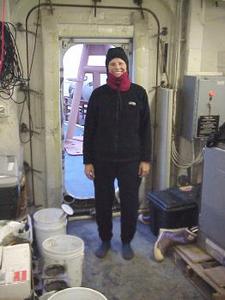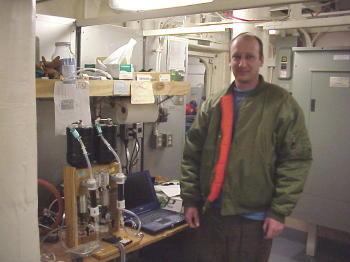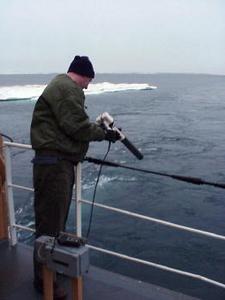6 August, 2002
Fleece is my friend! When out on deck this morning in
the cold wind and rain, my layers of fleece (pants,
jacket, neck warmer and hat) combined with all my
other cold weather gear kept me relatively warm. The
cold weather and the darker morning hours (remember
that this area will experience 24 hour darkness
beginning in late November) were a reminder that
“summer” is definitely on the way out here in the
Arctic Ocean. At 2 AM this morning, we were finishing
our sampling at East Hannah Shoal station #1. For my
students at home at Essex High School, be sure to note
the symbol, EHS #1. At EHS 2 and 3, the only sampling
that was done was with an XCTD or expendable CTD.
Some of those who had gone to sleep after sampling
water from the CTD bottles at EHS 1, were panicked
when they awoke to find we were at EHS 4. They were
convinced they had missed sampling two stations when
they had actually only been for the XCTD. Let me
explain what happened.
Mark Stephens and Dan Schuller were the ones deploying
the XCTD. At those sites, this is the only equipment
in use, and it takes only a short time to gather the
temperature and salinity data from it. Mark is an
assistant scientist at the University of Miami
Rosenstiel School of Marine and Atmospheric Science,
and Dan is a graduate student there. They are working
with David Kadko who was on the spring SBI cruise with
Mark. Their work involves more of the radioisotopes
I’ve talked about before. You might remember Rick
Nelson and Sandor Mulsow’s work with thorium-234
(journal for July 23), Jackie Grebmeier’s work with a
series of radioisotopes in the sediments (journal for
July 27). Mark and Dan are working with three
isotopes of radium to trace the water that comes off
the shelf and moves into the basin. They are
parcticularly interested in eddies that form near the
shore.
An eddy is somewhat like the water that goes down our
drain. It’s a circular water current which, in this
area, can have different types of water in the core
(the inside) and in the outer ring (the outside).
Depending on where the eddy was formed (i.e. on the
shelf break or off the shelf break), it will have
different radium levels in the core and in the outer
ring. By analyzing the water for radium isotopes,
they can distinguish which water is which. That is
because the radium isotopes give each type of water a
recognizable ‘fingerprint.” Radium is parcticularly
noticeable in water that comes off the shelf. Thorium
(remember Rick and Sandor) is found in the sediments
on the shelf, and it decays to radium which dissolves
in the water that travels over the shelf. Thus water
moving over the shelf receives an “injection” of
radium. As the water moves further out, it loses
radium at a known rate because it of radioactive
decay. By analyzing the amount of radium isotopes
along our transect, Mark and Dan can calculate the
rate of water movement off the shelf.
How do they do this? First they collect a LOT of
water! Since radium is found in such small amounts,
they must collect all the water from an entire CTD
cast. On that special cast, six bottles will collect
at one depth and six at another. At deep stations,
they will collect from four depths. In addition, they
always collect surface water. This is far too much
water to be transported, so they filter it through a
fiber that is coated with manganese, a substance that
picks up the radium. These fibers are then passed
through a counter on board for some of the radium
isotopes and then transported back to the University
of Miami where they will be analyzed for the other
radium isotopes, the ones that last longer before
breaking down.
Mark and Dan are parcticularly interested in this East
Hannah Shoal transect because this is an area where
both CTD and radium data indicated a possible eddy
during the spring cruise. The data wasn’t completely
clear and other data even suggest a different
conclusion. That’s why they are sampling all along
the transect, and that’s why they are putting out many
XCTDs along the way. If you look in the picture
below, you will see that Mark looks like he is firing
a gun off the stern. He’s actually firing the XCTD
into the water. The XCTD is connected to the gun and
the gun is connected to a computer which reads
temperature and salinity data from it. Once they have
their information, the XCTD is cut loose. The entire
process is a great example of science in action – test
and re-test until you collect enough data and
eliminate enough variables to reach a conclusion. The
spring cruise produced other data as well. They found
out that their radium results were supported by the
work of other scientists on board the spring cruise.
Evidence suggests that shelf water moves offshore in a
50 – 150 meter depth range.
Talking to Mark and Dan I was struck once again by the
wonderful interdisciplinary nature of science,
parcticularly on this cruise. For example, other
scientists are interested in the radium and XCTD data
so that they can assign a rate to the various
biological and chemical processes they are observing.
Thus the sharing of data is strongly encouraged and
shared through a ship computer network. Plots created
while underway are also hung up in the main lab. All
this data will be analyzed, combined and re-analyzed
in order to get a better picture of what is happening
to carbon as it moves through the Arctic Ocean. It’s
a long and involved process that leads to conclusions
that are strongly supported by the data.

Fleece is great! I'm wearing my fleece pants, jacket, neck warmer and hat before I put on my mustang suit, rubber-toed waterproof boots and fleece-lined waterproof gloves!

Because radium is found in such small amounts in the water, Mark and Dan have to collect LOTS of water for each sample.

Mark and Dan will filter all their water through fibers coated with manganese, a substance that will pick up the radium. Here Dan "fluffs" the fibers before placing them into the filter.

Mark Stephens is standing next to the counter that detects some of the radium isotopes that have adhered to the black, manganese-coated fibers. The rest of the analysis is done back at the University of Miami.

Mark launches one of the many XCTDs (expendable CTD) used on the cruise. Each one sends back temperature and salinity data before it is cut loose.
Contact the TEA in the field at
.
If you cannot connect through your browser, copy the
TEA's e-mail address in the "To:" line of
your favorite e-mail package.
|
